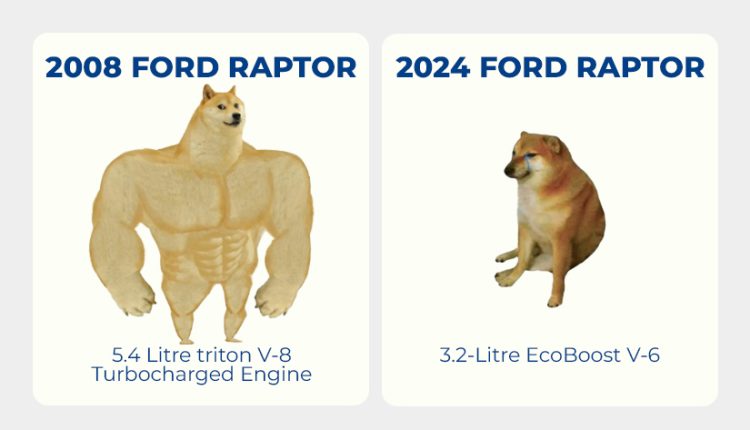Why Companies Opting for Smaller Engines?
 If you go back in time, you probably remember that old cars used to have massive engines. 2,000cc, 2,500cc, and 3,500cc engines were standard in many B and C-segment sedans. As time passed, they got smaller, and today’s modern cars usually come with 1,200cc, 1,500cc, and a max average of 1,800cc engines.
If you go back in time, you probably remember that old cars used to have massive engines. 2,000cc, 2,500cc, and 3,500cc engines were standard in many B and C-segment sedans. As time passed, they got smaller, and today’s modern cars usually come with 1,200cc, 1,500cc, and a max average of 1,800cc engines.
Car manufacturers are now preferring to build cars with smaller engines; even if it’s a D-segment sedan or C-segment SUV, you’ll probably notice some 1,500cc or 2,000cc average tiny displacement engines in them.
BUT WHY IS THAT?
Continue with this blog for in-depth information.
What’s up with Smaller Engine Trend?
There are a variety of reasons forcing the manufacturers to come up with smaller engine designs. Here’s our perspective on it:
Practicality and Fuel Economy
In old times, cars used to be a status symbol, but now they are being driven in more urbanized areas and are considered a practical mode of transportation rather than a status symbol.
Smaller displacement engines typically offer greater fuel efficiency compared to cars with larger displacements, making them a practical choice for commuters. Moreover, given the current higher fuel prices globally, vehicles with larger engines and lower fuel economy are no longer a viable option for many.
Many manufacturers are, therefore, shifting towards engines that offer greater fuel efficiency and adding electric features such as PHEV and HEV technologies to enhance overall economy.
Tax Reductions
Cars are considered a luxury in most countries, and therefore, governments worldwide impose a huge tax on them. Many governments impose taxes based on engine displacement, forcing manufacturers to design smaller engines to reduce tax burdens and consequently lower the MRP of the car.
Especially in Pakistan, importing a car with higher CCs is just too expensive to make sense. For example, the tax on vehicles above 1,000cc is 3.6 million PKR, more than 2x the tax on cars lower than 1,000cc, which is 1.6 million PKR.
Fun fact: Many 1,000cc cars aren’t actually 1,000cc; they’re listed as 996-998cc on paper. This slight reduction of 2-3cc saves almost 2 million in taxes on these cars.
That’s why you see many cars on paper with engine sizes of 1,497cc, 1,796cc, 1,999cc, and 2,998cc; they strategically adjust engine sizes to minimize tax liabilities.
Advancements in Technology
Did you see how big computers were in the 1990s? They used to take up entire desk space and weigh as a brick, they could barely playback a 144P video.
Now, we have ultra-thin laptops, which are, on average, 1.2 inches thick and weigh barely 2 Kg. They can easily playback and render 4K HDR 10 Dolby Vision videos.
Hence, as technology gets better, things tend to get smaller, and the same for the engines. As tolerances increase, materials enhance, and understanding of the engine gets better, their size shrinks, but the power output gets better or at least remains the same.
Electric Add-ons and Technological Additions
Increasing the displacement is no longer the only option to add more juice in the vehicle. Now manufacturers tend to go with electric trains, e.g., HEV and PHEV technologies. They work in combination with the gasoline engine to boost the overall power output while enhancing fuel economy and the vehicle’s overall efficiency + injecting more horsepower into the car.
Other than that, Honda uses its i-Vtec technology to increase the power output from the same engine by adjusting the valve timing at high RPMs. Turbo and Superchargers are also great at increasing the power output from the same engine by injecting more air into the engine.
Fun fact: You might have heard the stututututu sound from Turbocharged cars; it’s called “compressor surge.” Hear it again, you’ll love it!
SIZE DOESN’T MATTER
Bigger is not always better. Today’s small 2.5L engine can now have the same HP as a 4.4L V8 1970 engine. Just look at the Toyota’s 2JZ, which is a 3.0L engine that can be tuned to over 1200 HP or even more.
Power is not directly proportional to the displacement of the engine. The HP depends on the air intake, fuel combustion, the exhaust system, and the overall efficiency of the engine, as well as how the power is being transferred to the tires and the weight of the vehicle.
Therefore, the engine’s HP matters more than its CC. So, next time you’re buying a car and want to evaluate its power, prioritize its horsepower (HP) and torque figures rather than solely focusing on the engine’s displacement (CC).
Examples of cars that used to have larger engines but now come with smaller engines:
- 2024 Hyundai Tucson 2.0L engine
- 2010 Hyundai Tucson 2.4L engine
- 2018 BMW 5 Series PHEV (530e) 2.0L
- 2004 BMW 5 Series (E60) 4.4L
- Toyota Land Cruise LC300 with 3.3L V6
- Toyota Land Cruise LC200 with 4.8L V8
- 2024 Ford Raptor 3.5-liter EcoBoost V-6
- 2008 Ford Raptor Sema 5.4-liter Triton V-8 three-valve engine
- 2016 Honda Civic 1.8L
- 2022 Honda Civic 1.5L
- Corolla 9th Generation 2.0D Saloon with 2.0L
- Corolla 11th Generation Altis with 1.6L
- 2024 Honda Accord LX 1.5 Liter Engine
- 2002 Honda Accord CL9 2.7L Engine
- 2024 Lexus LX570 3.4L V6
- 2012 Lexus LX570 5.7L V8
- 2012 Range Rover Vogue with 5.0L V8 Engine
- 2022 Range Rover Vogue with 1.9L Engine
So, do you think size matters? Please share your thoughts in the comments section.



A very enjoyable read.